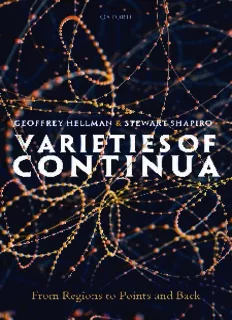
Varieties of Continua: From Regions to Points and Back PDF
Preview Varieties of Continua: From Regions to Points and Back
OUPCORRECTEDPROOF – FINAL,30/12/2017,SPi Varieties of Continua OUPCORRECTEDPROOF – FINAL,30/12/2017,SPi OUPCORRECTEDPROOF – FINAL,30/12/2017,SPi Varieties of Continua From Regions to Points and Back Geoffrey Hellman and Stewart Shapiro 1 OUPCORRECTEDPROOF – FINAL,30/12/2017,SPi 3 GreatClarendonStreet,Oxford,OX26DP, UnitedKingdom OxfordUniversityPressisadepartmentoftheUniversityofOxford. ItfurtherstheUniversity’sobjectiveofexcellenceinresearch,scholarship, andeducationbypublishingworldwide.Oxfordisaregisteredtrademarkof OxfordUniversityPressintheUKandincertainothercountries ©GeoffreyHellmanandStewartShapiro2018 Themoralrightsoftheauthorshavebeenasserted FirstEditionpublishedin2018 Impression:1 Allrightsreserved.Nopartofthispublicationmaybereproduced,storedin aretrievalsystem,ortransmitted,inanyformorbyanymeans,withoutthe priorpermissioninwritingofOxfordUniversityPress,orasexpresslypermitted bylaw,bylicenceorundertermsagreedwiththeappropriatereprographics rightsorganization.Enquiriesconcerningreproductionoutsidethescopeofthe aboveshouldbesenttotheRightsDepartment,OxfordUniversityPress,atthe addressabove Youmustnotcirculatethisworkinanyotherform andyoumustimposethissameconditiononanyacquirer PublishedintheUnitedStatesofAmericabyOxfordUniversityPress 198MadisonAvenue,NewYork,NY10016,UnitedStatesofAmerica BritishLibraryCataloguinginPublicationData Dataavailable LibraryofCongressControlNumber:2017950767 ISBN 978–0–19–871274–9 Printedandboundby CPIGroup(UK)Ltd,Croydon,CR04YY LinkstothirdpartywebsitesareprovidedbyOxfordingoodfaithand forinformationonly.Oxforddisclaimsanyresponsibilityforthematerials containedinanythirdpartywebsitereferencedinthiswork. OUPCORRECTEDPROOF – FINAL,30/12/2017,SPi Contents Preface vii . TheOldOrthodoxy(Aristotle)vstheNewOrthodoxy (Dedekind–Cantor) . TheClassicalContinuumwithoutPoints . AristotelianandPredicativeContinua WithØysteinLinnebo . RealNumbersonanAristotelianContinuum . Regions-basedTwo-dimensionalContinua:TheEuclideanCase . Non-EuclideanExtensions . TheMatterofPoints . Scorecard References Index OUPCORRECTEDPROOF – FINAL,30/12/2017,SPi OUPCORRECTEDPROOF – FINAL,30/12/2017,SPi Preface This work began several years ago with a series of discussions on competing con- ceptions of continua in mathematics, informed by late twentieth-century develop- ments,suchasRobinsoniannon-standardanalysisandthemoreradical,non-classical smoothinfinitesimalanalysis,thatrehabilitatedearliernotionsofinfinitesimals.At firstourplanswererathermodest—todoacomparativestudyofleadingapproaches tothecontinuous,assessingthetrade-offsinvolved,inamoresystematicandcom- prehensive way than what was already available in the literature. In particular, we were struck by the historical transition from the long-standing, Aristotelian non- punctiform conception to modern punctiform analysis based on the method of limits due to Bolzano, Cauchy, Weierstrass, Cantor, Dedekind, et al., which rapidly becamethedominantmainstreamapproach.Alongwiththecontrastbetweennon- punctiform, or regions-based, conceptions and the modern view of continua as entirely composed of points, there is also the contrast between potential infinity— againgoingbacktoAristotle—andtherecognitionofactualinfinitiesinmainstream modernmathematics.Herewewerestruckbythecircumstancethatrestrictionsto intuitionistic logic, also associated with potential infinity, have been motivated in radicallydifferentways,ontheonehandbydemandsofconstructivity(byBrouwer, Bishop,etal.),and,ontheother,byrestrictionsto“smoothmanifolds”(asinsmooth infinitesimalanalysis(SIA),especiallyasdescribedbyJohnBell),althoughthislatter way of motivating the restriction has been challenged by one of us. Also, we were motivated to assess intermediate, semi-constructive systems of predicative analysis (going back to Russell, Poincaré, Weyl, and perfected in work of Feferman et al.), basedonclassicallogic,recognizingactualinfinitybutonlyofpredicativelyjustifiable countabletotalities. Given this variety of systems and motivating ideas, it seemed clear to us that “continuity”isacluster-concept,realizableinmultiple,oftencompetingways,andthat nosinglesystemcoulddojusticetoallthedesiderataemergingfrommathematical andscientificpractice,pastandpresent. Itthenoccurredtousthatitoughttobepossibletoavoidtheshifttointuitionistic logic,alongwiththeapparatusofnil-potentinfinitesimals,whilestillbasinganalysis and geometry on the idea of regions or “chunks” of a given space or manifold, eschewingpoints,atleastaspartsofregions.Couldnotoneremain“classical”inone’s prooftheoryandtreatmentoftheinfinitewhilestillrealizingathoroughgoingnon- punctiformconceptionofcontinua?Wewere,ofcourse,alreadyfamiliarwithideas ofWhiteheadandothersonrecovering“points”asdefinedbysuitablynestedregions ofaspace.Wewere,however,surprisedathowlittlehadbeendoneinworkingout OUPCORRECTEDPROOF – FINAL,30/12/2017,SPi viii preface suchverynaturalideasrigorously,especiallybydeployingtheresourcesofatomless mereology,whichseemswell-suitedforsuchaproject.Inparticular,Tarskihadbegun suchaprojectinearlyworkwithLe´sniewski,supplementingmereologywiththesole primitive“sphere”inordertorecoverclassical,three-dimensionalgeometry.Buton closerexaminationwerealizedthatTarski’singeniousdefinitionswerenotsupplied withautonomousaxioms,beyondthoseofmereology,onthemathematicalprimitive, “sphere”, framed directly in terms of regions, so that the project remained in an incompletestate. Sowesetourselvesthetaskofcompletingsuchwork,butbeginningwiththesimple caseofacontinuumofonedimensionandthentryingtoextendsuchatreatmentto higher-dimensionalspaces.Thisinturninvolvedusinseekingtorecover,onthesame basisofregions,metricalstructuresofEuclideanandthennon-Euclideangeometries, ultimatelyresultinginthecorepositivedevelopmentsofthepresentwork. Itwascleartousfromtheoutsetthatthereisastronghistoricaldimensiontoour project,rootedasitisinideasgoingbacktoAristotle.Indeed,wecalloursystemfor a one-dimensional regions-based (“gunky”) continuum “semi-Aristotelian”, since it adheresstrictlytoAristotle’sdesideratumofnotbeingconstitutedofpointswhileat thesametimemakingfreeuseofactualinfinities,bothgeometricandset-theoretic (equivalentlydescribedvialogicofplurals).Thisinturnnaturallyledustoaskhowwe mightformulatemorefullyAristoteliantheoriesofcontinua,enforcingrestrictionto potentialinfinitiesonly.AsØysteinLinnebohadalreadyworkedoutformalismbased onmodallogicforexpressingpotentialinfinity,wepursuedathree-waycollaboration withhimforachapterdevotedtothistopic. At this stage, then, we had developed systems of analysis and geometry that are “semi-Aristotelian”, non-punctiform but “classical” with respect to actual infinities, andwehad“moreAristotelian”systemsthatwerebothnon-punctiformandconfined tothepotentiallyinfinite.Thatleftthefurtherpossibilityofpredicativesystems,lying betweenthemoreAristotelianandoursemi-Aristotelianones,basedonregions,using classical logic (without modality), but admitting only countably infinite totalities (correspondingtowell-foundedsettheorywithoutthepower–setsaxiom).Thedevel- opmentofsuchpredicativesystemsthenroundsoutourformalworkpresentedhere. Wethenturnedourattentiontodiscussingsomeoftheinterestingphilosophical implications of the formal developments, including the systematic comparisons of thedifferentapproachesthatmotivatedourprojectinthefirstplace,butalsoimpli- cationsfor various discussionsof contemporary analyticmetaphysics pertaining to applicationsofgeometryandanalysistomaterialobjectsofthenaturalworld,such ashowtounderstandormodel“contact”ofmaterialobjects,whethertoadmitpoint- likeobjects,andsoforth.Asexplainedbelow,manyofthesediscussionserrinsimply assuming that the geometry being applied pertains to punctiform spaces, whereas variousconundraevaporateinthecontextof“gunky”spaces. OUPCORRECTEDPROOF – FINAL,30/12/2017,SPi preface ix Finally,toroundoutthisvolume,wereturntoouroriginalthemeofcomparisons andtrade-offsamongthediverseconceptionsofcontinua,nowincludingtheregions- basedsystemsconstructedhere. We incurred many debts along the way. In the initial development of the one- dimensional,semi-Aristoteliansystem,wewerehelpedbyRoyCook,aformerstu- dent of one of us and a current colleague of the other, and by graduate students at our home institutions, notably Shay Logan at Minnesota and Patrick Reeder at Ohio State. Either together or separately, we gave presentations of early ver- sions of some of this material at a variety of conferences, workshops, and collo- quia, and were enlightened by comments from the audiences. The list includes the UniversityofMinnesota,theOhioStateUniversity,severalmeetingsoftheMidwest Philosophy of Mathematics Workshop, held annually at Notre Dame (and once in Illinois),theFoundationsInterestGroupattheMinnesotaCenterforPhilosophyof Science,Logica,thePhilosophyofScienceAssociation,theUniversityofSheffield,the University of Oslo, the University of California at Davis, the Hebrew University of Jerusalem, the University of Connecticut, the University of Southern California, and the University of St Andrews. Thanks to anonymous reviewers from Oxford UniversityPress,PhilosophiaMathematica,LogicandLogicalPhilosophy,Iyyun,and theReviewofSymbolicLogic.ThanksalsotoFrankArntzenius,JeremyAvigad,John Bell,EinarDuengerBohn,SarahBroadie,JohnBurgess,BenCaplan,TimCarlson, Aaron Cotnoir, Philip Ehrlich, Thomas Forster, James Franklin, Harvey Friedman, Giangiacomo Gerla, Charles Geyer, Rafał Gruszczyn´ski, Jeremy Heis, Eli Hirsch, Christopher Hookway, Jesse Houchens, Øystein Linnebo, Charles David McCarty, MarcoPanza,AndrzejPietruszczak,CarlPosy,AgustínRayo,BarbaraSattler,Wilfried Sieg, Allan Silverman, Reed Solomon, Gabriel Uzquiano, Achille Varzi, and Keren Wilson.Sincereapologiestoallofthosewhoshouldbementionedhere,butarenot. WeowealargedebtofgratitudetoHaidarAl-Dhalimyforamostcarefulproofreading of earlier drafts, developing the LaTeX code for our figures, and for help with the final proofreading and the index. Finally, thanks to Peter Momtchiloff, of Oxford UniversityPress,andhisstaff,forencouragingthisprojectandforguidingitthrough thevariousstagesofpublication.
Description: